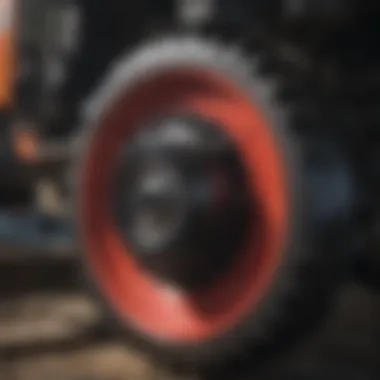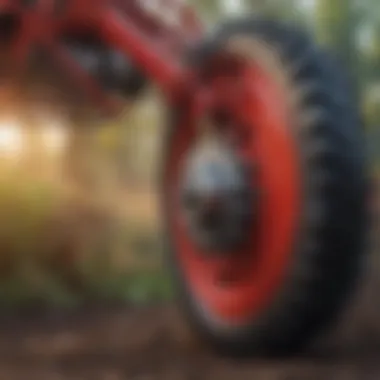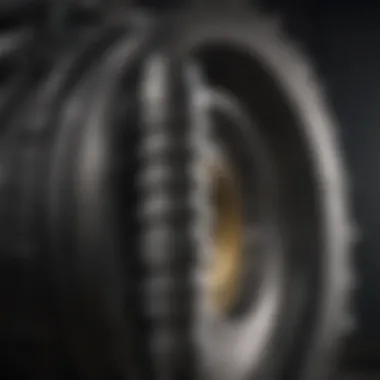Heavy Duty Down Pressure Springs in Agriculture


Intro
Heavy duty down pressure springs play a vital role in agricultural machinery. These components, often overlooked, significantly enhance the performance of various farming equipment. Their primary function revolves around providing the necessary force to maintain contact between tools and the ground. This ensures optimal operation, thus maximizing efficiency during various agricultural processes. This article provides an extensive overview of these springs, examining their functionalities, benefits, and different types available in the market.
Overview of the Topic
Definition and Importance
Heavy duty down pressure springs are mechanical devices designed to exert force downward. In agriculture, they are crucial for tools such as planters and cultivators. By applying consistent pressure, these springs ensure that implements maintain contact with the soil. Their importance cannot be underestimated; they help improve the precision of planting and the effectiveness of soil cultivation.
Moreover, these springs can adapt to different soil conditions, ensuring uniform performance no matter the environment. This adaptability translates into better crop yields and reduced resource waste, making them essential in modern agricultural practices.
Current Trends
In recent years, there has been a noticeable shift towards more advanced materials and technologies in the manufacturing of down pressure springs. Farmers increasingly favor springs made from high-strength alloys, which offer greater durability and resistance to fatigue. Additionally, the integration of smart technology is becoming more popular. Sensors embedded within machinery can adjust the spring pressure based on real-time soil conditions, optimizing operational efficiency and helping to manage resources better.
Key Techniques and Practices
Step-by-Step Guide
- Identify Your Needs: Understand the specific requirements of your machinery and the soil conditions where they will be used.
- Select the Appropriate Spring: Choose a spring that matches the specifications and the load requirements of your equipment.
- Installation: Properly install the springs according to the manufacturer’s instructions. Ensure all components are secure to avoid mechanical failure.
- Adjust as Necessary: Periodically check the performance of the springs and make adjustments based on changing conditions or wear.
- Maintenance: Regularly inspect for signs of damage or wear. Replace any components as needed to maintain optimal performance.
Tools and Equipment Needed
To work effectively with these springs, farmers may need:
- A torque wrench for precise adjustments
- Plier or spring tool for handling springs
- Safety Goggles for protection during installation and maintenance
- A calibration tool for checking tension settings
Challenges and Solutions
Common Obstacles
While using heavy duty down pressure springs, farmers might face several challenges. One common obstacle is the wear and tear that springs undergo due to harsh working conditions. Soil abrasiveness can lead to early fatigue, making it necessary to frequently replace springs. Another challenge includes the difficulty of maintaining the correct pressure at varying soil moisture levels.
Innovative Solutions
To combat these challenges, many farmers are adopting innovative practices. For example, utilizing advanced materials, like composite springs, can enhance durability against wear. Furthermore, employing adjustable pressure mechanisms allows farmers to optimize the down pressure based on real-time soil conditions. Investing in quality maintenance practices can also prolong the lifespan of these components.
"The ongoing evolution of agricultural technology allows farmers to achieve unprecedented levels of efficiency and sustainability in their operations."
In summary, heavy duty down pressure springs are not just mechanical components but are key players in modern agricultural efficiency. Understanding their functionalities, selection process, and maintenance practices can empower farmers to enhance their equipment performance, substantially impacting agricultural productivity.
Foreword to Heavy Duty Down Pressure Springs
Heavy duty down pressure springs play a pivotal role in modern agricultural practices. They are essential components that support various equipment, directly affecting productivity and operational efficiency. Farmers and agricultural engineers benefit from understanding the dynamics of these springs, as they influence both soil management and crop yield.
Definition and Purpose
Down pressure springs are mechanical devices designed to apply force against an object. In agriculture, their primary purpose is to ensure that tools penetrate the soil with adequate force. This action is crucial during processes such as tilling, planting, and soil preparation. By maintaining consistent pressure, they help achieve optimal soil conditions. Additionally, they contribute to equipment stability, helping minimize wear and tear on agricultural machinery.
Examples of where these springs are used include seeders, plows, and harvesting machines. Their application ensures that machinery operates at peak performance, leading to more efficient farming practices.
Historical Context
The use of springs in agricultural equipment goes back many years. Initially, farming relied on simple mechanical designs that often lacked flexibility or the ability to adapt to varied soil conditions. Over time, as farming practices evolved, so did the technology behind agricultural machinery. The introduction of down pressure springs marked a significant advancement.
In the mid-20th century, with the rise of mechanized farming, the necessity for enhanced equipment performance became evident. Machinery needed to adapt to diverse conditions, from rocky to loose soils. The incorporation of heavy duty down pressure springs into various machines provided a solution. Farmers began to see improved planting depths and more effective soil preparation. As agricultural methodologies advanced, these springs became integral parts of new designs, underscoring their importance in modern farming.
Mechanics of Down Pressure Springs
Understanding the mechanics of down pressure springs is crucial in optimizing their application in agricultural practices. These springs play a vital role in ensuring that machinery operates efficiently under varying load conditions. By maintaining the correct level of down pressure, they assist in effective soil penetration, seed placement accuracy, and overall equipment performance. Proper operation and selection can lead to enhanced agricultural productivity, which is why analyzing these mechanics is essential.
Basic Principles of Operation
Down pressure springs operate based on the fundamental principle of storing potential energy and releasing it when necessary. When a force is applied, the springs compress or stretch, absorbing energy. Upon release, this energy helps to push implements into the soil or maintain tension on various components of agricultural machinery.


This interaction between force and spring mechanism is how down pressure springs ensure that equipment can adapt to the contours of the terrain. As the machinery encounters uneven ground, the springs regulate the pressure applied to the soil, facilitating consistent penetration and seed placement. Therefore, understanding how these springs operate is crucial for any agricultural professional looking to improve the performance of their equipment.
Types of Down Pressure Springs
The selection of down pressure springs involves understanding the various types available, each with unique characteristics that make them suitable for specific applications in agriculture.
Compression Springs
Compression springs are designed to resist axial loads and provide high stability when compressed. The key characteristic of compression springs is their ability to store energy efficiently when pushed together. This feature is particularly beneficial in applications requiring consistent and strong down pressure on planting or tilling equipment. Compression springs can be tailored to various load requirements, making them a popular choice in agricultural setups. However, it's important to consider the limitations on their compression rate to avoid premature fatigue or failure over time.
Tension Springs
Tension springs serve to resist stretching forces. The significant feature of tension springs is their role in maintaining tension in agricultural machinery. They are commonly used in equipment where it is necessary to apply a pulling force, such as in seeders or cultivators. The advantage of this type of spring is its ability to provide dynamic tension adjustment, crucial for adapting to different operational conditions. On the downside, choosing the wrong tension spring can result in insufficient pulling force, decreasing operational efficiency.
Extension Springs
Extension springs are designed to absorb and store energy in a stretched state. This type of spring is essential where components need to be pulled apart or require additional force to reopen after compression. The main benefit of extension springs is their strong return force, which can enhance equipment responsiveness during operation. However, these springs must be carefully calibrated to avoid over-extension, which can lead to equipment malfunction or reduced lifespan.
Applications in Agriculture
Heavy duty down pressure springs play a pivotal role in modern agricultural practices. Their applications span various tasks, each contributing significantly to optimizing the performance of agricultural machinery. Understanding these applications is critical for farmers and enthusiasts aiming to enhance efficiency and productivity in their operations. With the complexities of soil interactions, planting technologies, and harvest mechanisms, heavy duty down pressure springs serve essential functions that highlight their importance in agriculture.
Role in Soil Preparation
In soil preparation, heavy duty down pressure springs ensure that tillage equipment achieves optimal penetration into the ground. They provide the necessary force to press tools into the soil, improving the effectiveness of tasks such as plowing and soil aeration. The design of these springs allows for consistent performance, maintaining adequate force even in challenging soil conditions. This capability reduces the risk of soil compaction, which is detrimental to crop growth. Moreover, implementing proper down pressure enables more uniform seedbed preparation, ultimately leading to improved yield potential.
- Enhanced Penetration: Down pressure springs help implements penetrate deeper, leading to better root development for crops.
- Soil Health: By optimizing tillage depth and reducing compaction, these springs contribute positively to soil health.
- Versatility: Different types of springs can adapt to various equipment, making them versatile tools in different soil types and weather conditions.
Impact on Planting Equipment
Planting equipment benefits tremendously from heavy duty down pressure springs. These springs facilitate precise control over planting depth and seed placement, crucial for ensuring that seeds are sown at the correct intervals and depths. This precision reduces seed waste and enhances germination rates.
Additionally, by applying the right amount of down pressure, equipment can adjust to different field conditions, promoting even planting across varied terrains. This adaptability prevents the issues of overly packed or too loose planting, which can lead to inconsistent crop growth.
- Improved Seed Placement: Ensures that seeds are buried at an optimal depth for germination.
- Reduced Seed Loss: Effective pressure helps minimize seed bounce and waste during planting.
- Optimized Plant Spacing: Critical for maintaining proper crop density and maximizing yield potential.
Usage in Harvesting Machines
During harvesting, heavy duty down pressure springs enable harvesting machines to maintain contact with the crop at all times. These springs are vital for ensuring that machines operate efficiently, minimizing losses and improving the quality of harvested produce. When the pressure is correctly adjusted, these springs aid in the smooth operation of cutting blades and other harvesting components, adapting to varying crop densities and field conditions.
Proper integration of these springs in harvesting equipment enhances durability and performance. Farmers benefit from reduced downtime as these springs help maintain consistent pressure and prevent machinery from becoming overloaded or malfunctioning.
- Consistent Harvesting Performance: Helps machines remain efficient without damaging crops.
- Enhanced Crop Quality: Minimized physical stress on crops reduces bruising and other damage.
- Increased Operational Efficiency: Fewer adjustments are needed during harvesting, leading to less wasted time.
"The application of heavy duty down pressure springs in agriculture can substantially improve both productivity and the quality of yields. Their importance cannot be overstated in practices that require precision and adaptability."
In summary, heavy duty down pressure springs serve as a crucial element in the applications of agriculture. They enhance soil preparation, improve planting processes, and optimize harvesting methods. Understanding these functions allows agricultural professionals to leverage technology and improve operational efficiency.
Benefits of Heavy Duty Down Pressure Springs
Heavy duty down pressure springs serve a vital role in modern agricultural machinery. Understanding their benefits supports effective farming practices. This section explores several key advantages including increased durability, enhanced equipment performance, and significant operational cost reductions. The emphasis here is on how these springs contribute to overall efficiency and productivity in agriculture.
Increased Durability and Longevity
Heavy duty down pressure springs are designed with durability in mind. Made from high-quality materials like alloy steel, these springs endure the rigorous demands of agricultural use. They can withstand extreme conditions such as harsh weather, soil abrasion, and heavy workloads. This resilience reduces the need for frequent replacements, thus offering long-term reliability.
With less downtime for repairs or replacements, farmers can maintain higher productivity. This durability also translates into fewer operational disruptions. For example, springs that fail often can halt planting or harvesting. Conversely, robust springs ensure that machinery operates smoothly through different seasons.
Enhanced Equipment Performance
The performance of agricultural equipment relies heavily on the components within. Heavy duty down pressure springs play a crucial role in regulating force applied by various implements. This ability to adjust pressure optimizes the interaction between tools and the soil. As a result, farmers can achieve better seed placement, improved soil contact, and enhanced tillage results.
These improvements lead to a more effective planting process. When equipment performs at its best, crop yields are likely to increase. In turn, this efficiency can drive profitability. Using reliable down pressure springs makes a notable difference in achieving these outcomes.
Reduction in Operational Costs


One of the most significant benefits of heavy duty down pressure springs relates to cost savings. Durable springs with a longer lifespan mean fewer replacements, which directly impacts the expenses related to parts and maintenance. Additionally, enhanced performance often results in less fuel consumption. When machinery runs optimally, less energy is needed to operate it.
Farming is an industry where margins can be tight. By cutting down on operational costs, farmers can allocate resources better. This can lead to investments in other essential areas, like technology or crop management practices.
"Investing in quality springs not only enhances performance but also leads to substantial long-term savings."
In summary, heavy duty down pressure springs contribute significantly to agriculture by increasing durability, improving equipment performance, and reducing operational costs. Each advantage supports better practices that ultimately benefit productivity and profitability. Understanding these benefits helps farmers make informed decisions about their machinery investments.
Considerations for Selection
Selection of heavy duty down pressure springs requires careful assessment. Each element plays a crucial role in ensuring optimal performance and longevity. Not properly considering these factors can lead to inefficiency and increased costs. Farmers and agricultural professionals must pay attention to three primary aspects: load requirements, material composition, and size and dimensions.
Load Requirements
Understanding load requirements is fundamental. Each spring must support specific weights without failing. The load typically encompasses both static and dynamic forces.
- Static Load: This is the weight that the spring supports while in a resting state. It is essential for applications like soil preparation where consistent pressure is needed.
- Dynamic Load: This refers to forces acting on the spring when machinery is in motion. For instance, a harvester experiences varying loads due to the changing terrain and weight of crops.
Farmers should calculate their machinery's load needs accurately. Overloading can cause immediate damage, while underloading leads to ineffective performance.
Material Composition
Material choice affects both strength and flexibility of the springs. The right materials can improve durability and resistance to extreme conditions. Common materials include:
- High Carbon Steel: Known for its strength, it is often the first choice due to its capability to withstand heavy loads.
- Stainless Steel: While slightly less strong than high carbon steel, it offers superior corrosion resistance, making it suitable for wet conditions.
- Alloy Steel: It combines various elements to enhance specific properties, such as flexibility or heat resistance.
Selecting the appropriate material can significantly impact the overall life cycle of the spring and its resistance to environmental factors.
Size and Dimensions
Correct sizing is essential to ensure the springs fit their designated application. Oversized or undersized springs can lead to malfunctioning equipment or increased wear. Key dimensions to consider include:
- Wire Diameter: This influences the spring's overall strength and resistance to deformation under load.
- Free Length: The spring's length when not under any load. This dimension needs to match equipment specifications for proper performance.
- Coil Diameter: Affects the spring's ability to compress or extend, thereby impacting its performance in various applications.
Maintenance of Down Pressure Springs
Maintaining the functionality and performance of down pressure springs is crucial for maximizing their effectiveness in agricultural machinery. Given the demanding nature of agricultural operations, neglecting maintenance can lead to decreased efficiency, unplanned downtimes, and even costly repairs. Focusing on routine maintenance is key to ensure these springs work optimally throughout their service life. Regular maintenance not only protects investments but also enhances equipment reliability.
Regular Inspection Protocols
Establishing a routine inspection protocol is essential. Inspections should occur at defined intervals to catch any signs of wear or stress early on. Here are some critical aspects to include in inspection protocols:
- Visual Checks: Look for signs of corrosion, cracks, and deformation. Even small cracks can be a precursor to failure.
- Functionality Assessment: Test the springs under normal operational conditions to confirm that they return to their original position and resist loads appropriately.
- Check Alignment: Springs should be correctly aligned to the machinery to prevent uneven wear or stress.
- Documentation: Keep detailed records of inspections and any findings for future reference.
Common Issues and Solutions
Down pressure springs can face several issues over time. Identifying these problems quickly can minimize their impact on machinery performance:
- Excessive Wear: Regular operation can lead to fatigue. If springs show significant wear, replacement may be necessary.
- Corrosion: Exposure to moisture or chemicals can cause rust. Applying protective coatings can prolong life.
- Loss of Tension: Springs may become less effective due to stretching. Consider replacing fatigued springs promptly.
- Misalignment: Always check the placement and positioning. Misalignment can cause uneven pressure and additional stress.
For each issue, identifying the root cause is critical. Some solutions require simple adjustments, while others may necessitate replacing the springs entirely.
Best Practices for Longevity
To increase the lifespan and efficiency of down pressure springs, adhere to the following best practices:
- Environment Protection: Store equipment in a dry, protected environment to prevent rust and damage.
- Quality Parts: Invest in high-quality springs designed for the specific application to ensure durability.
- Routine Lubrication: Applying lubricant can reduce friction and wear.
- Education and Training: Ensure all users are aware of proper operation and maintenance protocols.
"Proper maintenance of down pressure springs not only extends their lifespan but also enhances the overall efficiency of agricultural machinery."
By following these protocols, solutions, and best practices, equipment operatives can greatly improve the performance and longevity of down pressure springs, leading to enhanced agricultural productivity.
Integration with Other Agricultural Technologies
The integration of heavy duty down pressure springs with other agricultural technologies is vital for optimizing farm operations. As part of modern agricultural machinery, these springs enhance the functionality and overall performance of equipment. By working harmoniously with precision agriculture tools and tillage operations, they contribute significantly to increased productivity and efficiency in agricultural practices.


Compatibility with Precision Agriculture Tools
Heavy duty down pressure springs play a crucial role in the realm of precision agriculture. These springs enable farmers to apply appropriate downforce on planting equipment, which is essential for effective seed placement. The correct downforce ensures that seeds are planted at optimal depth, resulting in better germination rates and improved crop yields.
Furthermore, the integration with tools such as GPS-guided systems and variable rate technologies allows for accurate data-driven decisions. By adjusting the downforce based on real-time soil conditions, farmers can maximize efficiency while minimizing waste.
- Key Benefits:
- Improved seed-to-soil contact
- Enhanced planting accuracy
- Reduction in seed waste
As precision agriculture continues to evolve, the advancement in down pressure spring technology will likely become more significant. Future developments may include sensors that monitor soil conditions and adjust downforce automatically, leading to even greater precision and efficiency.
Role in Tillage Operations
In tillage operations, heavy duty down pressure springs are fundamental components that influence soil preparation. They provide crucial support to various tillage implements, including plows and cultivators, by enabling consistent pressure on the soil. This is essential for achieving uniform soil tilth and effective weed control.
Moreover, these springs can help in preventing equipment bounce, ensuring that the tillage tool remains in contact with the soil. This consistent contact leads to better soil mixing and improves the efficacy of seedbed preparation.
- Operational Advantages:
- Consistent working depth
- Enhanced soil structure improvement
- Reduced fuel consumption due to increased efficiency
Integrating heavy duty down pressure springs in tillage operations not only optimizes land preparation, but also contributes to sustainable farming practices. By improving soil health and reducing the need for chemical inputs, these springs support both economic and environmental objectives in agriculture.
Future Trends in Down Pressure Springs Technology
The field of agricultural technology is continuously evolving, and down pressure springs are no exception. As we move toward a sustainability-oriented approach, it's crucial to assess how these springs will adapt. Future trends in down pressure springs technology not only promise improvements in functionality but also aim to enhance efficiency in agricultural practices. Innovations in this area can lead to better crop yields and reduced costs for farmers.
Innovations in Material Science
Material science plays a vital role in the advancement of heavy duty down pressure springs. Manufacturers are beginning to explore alternative materials that offer improved strength-to-weight ratios. Composite materials, for instance, can lead to lighter springs that retain durability. This reduction in weight can enhance the overall efficiency of machinery, as less energy is required to operate lighter components.
Moreover, surface treatments are evolving. New coatings can provide increased resistance to corrosion and wear, extending the lifespan of down pressure springs. Enhanced material properties can ultimately translate into cost savings. These developments in material science lay the groundwork for future robust, adaptable agricultural equipment.
Smart Springs and IoT Applications
The integration of smart technology in agriculture is a trend that cannot be ignored. Smart down pressure springs equipped with sensors can provide real-time data feedback to operators. This technology can inform farmers about the level of force being exerted, soil conditions, and even the performance of the equipment itself. The result is improved decision-making based on accurate, timely information.
The Internet of Things (IoT) is revolutionizing agricultural practices. When down pressure springs collaborate with IoT applications, farmers can monitor their machinery remotely, enhancing operational efficiency. Alerts about potential failures or required maintenance can significantly reduce downtime and maintenance costs.
"Smart technology in agriculture allows for greater monitoring and optimization of resources, leading to more sustainable practices."
The future trends in down pressure springs technology signal a shift towards more advanced solutions that prioritize efficiency, durability, and adaptability. As these technologies continue to develop, their potential to transform agricultural practices will undoubtedly become even more pronounced.
End
The conclusion serves a crucial role in synthesizing the information presented in this article about heavy duty down pressure springs in agriculture. As farmers and agricultural professionals navigate the complexities of modern farming, understanding the significance of these springs can lead to substantial improvements in both efficiency and productivity.
Summary of Key Points
- Heavy duty down pressure springs are essential components that enhance the performance of various agricultural machinery.
- These springs contribute to more effective soil management, planting strategies, and harvesting techniques.
- Key advantages of using these springs include increased durability, enhanced equipment performance, and lower operational costs.
- Careful selection based on load requirements, material composition, and size is critical to their effectiveness.
- Regular maintenance and understanding of integration with other technologies are necessary for optimal use.
Recommendations for Practitioners
- Assess Equipment Needs: Evaluate specific machinery to determine the type and specifications of down pressure springs required.
- Prioritize Quality: Invest in high-quality springs made from durable materials to ensure longevity and performance.
- Routine Inspections: Implement a schedule for regular inspections to identify wear and tear early.
- Stay Updated: Keep abreast of advancements in technology, such as smart springs and IoT applications that may enhance machinery efficiency.
- Train Staff: Ensure that users are educated on the operational specifics and maintenance requirements of down pressure springs.
Emphasizing the role of heavy duty down pressure springs helps in achieving better agricultural outcomes.
Importance of Accurate References
Accurate references provide a foundation for knowledge in any field, including agriculture. The use of established data helps professionals make informed decisions based on current research and technological advancements. As agricultural practices evolve, so does the technology that supports it. Heavy duty down pressure springs play a pivotal role in this context. Their effectiveness relies on the latest innovations and empirical studies that validate their performance.
Benefits of Using Well-Researched References
- Credibility: Citing credible references establishes trust among peers and stakeholders in agricultural communities. When farmers or manufacturers understand that insights are grounded in solid research, they are more likely to adopt new practices or technologies.
- Enhanced Knowledge: Engaging with well-documented material allows for a broader understanding of the subject. For instance, accessing detailed studies may provide insight into how specific materials affect the durability of springs, which in turn influences selection criteria for agricultural applications.
- Benchmarking: References offer benchmarks that aid in evaluating the relative performance of different types of down pressure springs across various applications. This comparative analysis can reveal which innovations are advantageous for specific farming operations.
Considerations in Selecting References
When evaluating references, several factors should be taken into account:
- Relevancy: Ensure that the material directly relates to heavy duty down pressure springs within the agricultural context. Outdated or tangential information can mislead users.
- Expertise of Authors: Check the qualifications and backgrounds of those who produced the material. Authors with experience in agricultural machinery or engineering provide more reliable insights.
- Publication Source: Review the publication’s integrity. Peer-reviewed journals, academic institutions, and industry-specific publications usually maintain higher standards of information.
In summary, sourcing high-quality references is not merely a matter of compliance but a significant factor that influences understanding, decision-making, and ultimately the success of agricultural operations utilizing heavy duty down pressure springs. Farmers and agricultural engineers benefit greatly from the insights found within these documents, enabling them to optimize the performance of their machinery efficiently.



